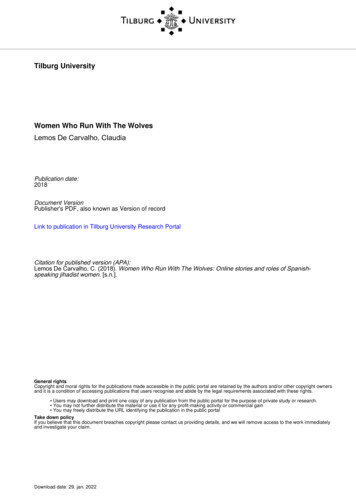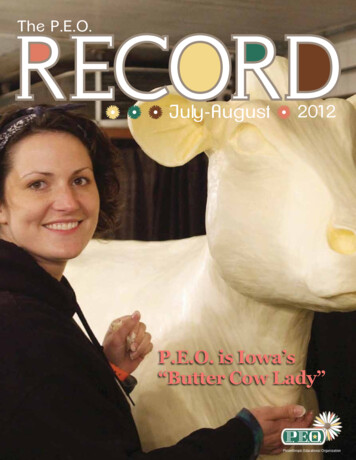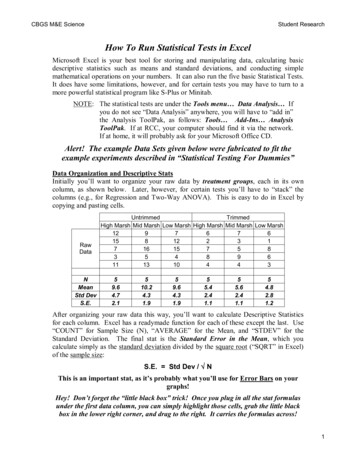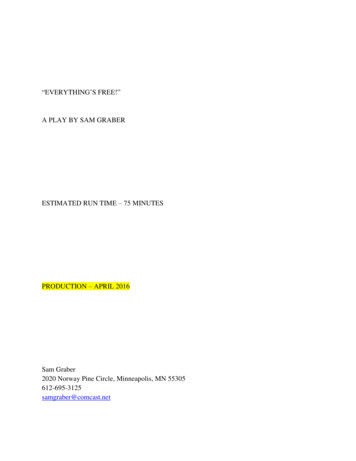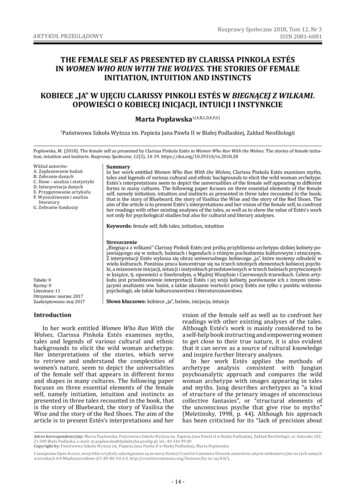
Transcription
Rozprawy Społeczne 2018, Tom 12, Nr 3ISSN 2081-6081ARTYKUŁ PRZEGLĄDOWYTHE FEMALE SELF AS PRESENTED BY CLARISSA PINKOLA ESTÉSIN WOMEN WHO RUN WITH THE WOLVES. THE STORIES OF FEMALEINITIATION, INTUITION AND INSTINCTSKOBIECE „JA” W UJĘCIU CLARISSY PINKOLI ESTÉS W BIEGNĄCEJ Z WILKAMI.OPOWIEŚCI O KOBIECEJ INICJACJI, INTUICJI I INSTYNKCIEMarta Popławska1(A,B,C,D,E,F,G)Państwowa Szkoła Wyższa im. Papieża Jana Pawła II w Białej Podlaskiej, Zakład Neofilologii1Popławska, M. (2018). The female self as presented by Clarissa Pinkola Estés in Women Who Run With the Wolves. The stories of female initiation, intuition and instincts. Rozprawy Społeczne, 12(3), 14-19. https://doi.org/10.29316/rs.2018.28Wkład autorów:A. Zaplanowanie badańB. Zebranie danychC. Dane – analiza i statystykiD. Interpretacja danychE. Przygotowanie artykułuF. Wyszukiwanie i analizaliteraturyG. Zebranie funduszySummaryIn her work entitled Women Who Run With the Wolves, Clarissa Pinkola Estés examines myths,tales and legends of various cultural and ethnic backgrounds to elicit the wild woman archetype.Estés’s interpretations seem to depict the universalities of the female self appearing in differentforms in many cultures. The following paper focuses on three essential elements of the femaleself, namely initiation, intuition and instincts as presented in three tales recounted in the book;that is the story of Bluebeard, the story of Vasilisa the Wise and the story of the Red Shoes. Theaim of the article is to present Estés’s interpretations and her vision of the female self, to confronther readings with other existing analyses of the tales, as well as to show the value of Estés’s worknot only for psychological studies but also for cultural and literary analyses.Keywords: female self, folk tales, initiation, intuitionTabele: 0Ryciny: 0Literatura: 11Otrzymano: marzec 2017Zaakceptowano: maj 2017IntroductionStreszczenie„Biegnąca z wilkami” Clarissy Pinkoli Estés jest próbą przybliżenia archetypu dzikiej kobiety pojawiającego się w mitach, baśniach i legendach o różnym pochodzeniu kulturowym i etnicznym.Z interpretacji Estés wyłania się obraz uniwersalnego kobiecego „ja”, które możemy odnaleźć wwielu kulturach. Poniższa praca koncentruje się na trzech istotnych elementach kobiecej psychiki, a mianowicie inicjacji, intuicji i instynktach przedstawionych w trzech baśniach przytoczonychw książce, tj. opowieści o Sinobrodym, o Mądrej Wasylisie i Czerwonych trzewikach. Celem artykułu jest przedstawienie interpretacji Estés i jej wizji kobiety, porównanie ich z innymi istniejącymi analizami ww. baśni, a także ukazanie wartości pracy Estés nie tylko z punktu widzeniapsychologii, ale także kulturoznawstwa i literaturoznawstwa.Słowa kluczowe: kobiece „ja”, baśnie, inicjacja, intuicjaIn her work entitled Women Who Run With theWolves, Clarissa Pinkola Estés examines myths,tales and legends of various cultural and ethnicbackgrounds to elicit the wild woman archetype.Her interpretations of the stories, which serveto retrieve and understand the complexities ofwomen’s nature, seem to depict the universalitiesof the female self that appears in different formsand shapes in many cultures. The following paperfocuses on three essential elements of the femaleself, namely initiation, intuition and instincts aspresented in three tales recounted in the book, thatis the story of Bluebeard, the story of Vasilisa theWise and the story of the Red Shoes. The aim of thearticle is to present Estés’s interpretations and hervision of the female self as well as to confront herreadings with other existing analyses of the tales.Although Estés’s work is mainly considered to bea self-help book instructing and empowering womento get close to their true nature, it is also evidentthat it can serve as a source of cultural knowledgeand inspire further literary analyses.In her work Estés applies the methods ofarchetype analysis consistent with Jungianpsychoanalytic approach and compares the wildwoman archetype with images appearing in talesand myths. Jung describes archetypes as “a kindof structure of the primary images of unconsciouscollective fantasies”, or “structural elements ofthe unconscious psyche that give rise to myths”(Meletinsky, 1998, p. 44). Although his approachhas been criticised for its “lack of precision aboutAdres korespondencyjny: Marta Popławska, Państwowa Szkoła Wyższa im. Papieża Jana Pawła II w Białej Podlaskiej, Zakład Neofilologii, ul. Sidorska 102,21-500 Biała Podlaska, e-mail: m.poplawska@dydaktyka.pswbp.pl, tel.: 83 344 99 00Copyright by: Państwowa Szkoła Wyższa im. Papieża Jana Pawła II w Białej Podlaskiej, Marta PopławskaCzasopismo Open Access, wszystkie artykuły udostępniane są na mocy licencji Creative Commons Uznanie autorstwa-użycie niekomercyjne-na tych samychwarunkach 4.0 Międzynarodowe (CC BY-NC-SA 4.0, .- 14 -
Rozprawy Społeczne 2018, Tom 12, Nr 3The female self as presented by Clarissa Pinkola Estés.the nature of the relationship between myth andarchetype” (Meletynsky, 1998, p. 45) which leadssome scholars to consider every image a myth, orfor its ignorance of the social aspects of myths andlegends in favour of the psychological dimension,it cannot be denied that it allows us to reconsiderour attitude to myths, legends and folktales andappreciate their value as meaning-bearing culturalartefacts. Drawing from Jung’s theories, Estésrediscovers the richness of narrative folklore andits universal meaning for the modern woman.undermines a robust folkloric tradition in which theheroine is a resourceful agent of her own salvation.Rather than celebrating the courage and wisdom ofBluebeard’s wife in discovering the dreadful truthabout her husband’s murderous deeds, Perrault andmany other tellers of the tale disparage her unrulyact of insubordination.” (Tatar, 2002, p. 147) Apartfrom the theme of knowledge acquisition, otherpossible interpretations include taboos surroundingthe acquisition of wealth and high social status bya woman or depicting irrational male evil. Freudianinterpretations focus on sexuality where “the key isphallic, while the lock into which it is inserted and theforbidden chamber are both vaginal” (Hermansson,2009, p. XV). Scholars also focus on the wife’stransgression interpreted as sexual infidelity andthe following punishment as the husband’s rightto execute his unfaithful wife practised in somecultures. Feminist readings of the tale suggest thatthe fact that Bluebeard’s wives are slain for lookinginto the forbidden chamber is a warning for womenagainst becoming excessively acquainted with theirown bodies. Furthermore, postmodern feminists seethe chamber as representing History, particularlythe history of male physical and sexual violenceinflicted on women with the support of culture(Hermansson, 2009). All in all, the most elementalinterpretations centre around a prohibition andits transgression, and Bluebeard’s wife is seen as“a fairy tale representation of the archetype offemale transgressive curiosity” (Hermansson, 2009,p. 15).Estés’s interpretation is consistent with Jungianpsychoanalysis in which “the conflict betweenBluebeard and his wife is between two warringaspects of the psyche, reconciliation of which isnecessary to individuation” (Hermansson, 2009,p. XVI). Individuation is a term used by Jung todescribe “the process of personality developmentwhich leads to the fullest possible actualization ofthe Self. Individuation means becoming a single,homogeneous being, and, in so far as ‘individuality’embraces our innermost, last, and incomparableuniqueness, it also implies becoming one’s ownself. We could therefore translate individuationas ‘coming to selfhood’ or ‘self-realization’”(Stevens, 2002, p. 354) . Since it plays a vital rolein the development of the self, it is not surprisingthat individuation is perceived as one of the mostfundamental archetypes appearing in Jungiananalytical psychology and is said to occur in themajority of folk tales (Gary, El Shamy, 2005).Therefore for Estés, the Bluebeard tale is aboutthe captor, or the innate predator who resides inall women’s psyches, who represents an “againstnature” force which prevents development,disrupts harmony and “acts in opposition to theinstincts of the natural Self” (Estés, 1995, p. 45).According to Estés, every woman should be awareof the predator’s existence and the knowledge isessential for her to become a mature creature “whoBluebeardThe first tale recounted by Estés to be discussedis the story of Bluebeard, which is a well-knownfolktale whose different versions can be found inmany cultures but whose first written version waspublished by Charles Perrault in 1697 (Zipes, 2007).In short, it is a story of a noble man who in spite ofhis obvious monstrosity, in the story depicted in theform of his awe-inspiring ugly blue beard, succeedsin persuading a young girl to marry him. One dayprior to his departure, Bluebeard encourageshis young wife to enjoy herself in his mansionand do whatever she desires to on condition thatshe does not open the door of a certain forbiddenroom. During his absence, however, the youngwife disobeys her husband’s order and, urgedby her older sisters, walks into the mysteriouschamber, discovering Bluebeard’s secret. The roomis filled with bloody corpses of his previous wives.Horrified and determined to avoid the fate of herpredecessors, the girl tries to obliterate the tracesof her visit to the room by hiding the key, which gotstained and started to bleed. Bluebeard, shown asa cunning predator, soon learns about the youngwife’s misbehaviour and wants to murder her. Heis, however, prevented by the girl’s brothers whomanage to rescue her in time and kill Bluebeard(Estés, 1995).Undeniably, there are multiple interpretations ofthe story and, what is more, it is noticed by critics thatthe versions appearing in different traditions leavethe reader with completely different impressions– the Italian and the English versions producehumorous effects, the German versions are horrificand the French seem dramatic (Hermansson, 2009).Traditionally, however, the tale’s interpretationsfollow Perrault’s moral to the story and revolvearound the theme of “the evils of female curiosity”(Zipes, 2000, p. 56), depicted in the figure of the youngwife who cannot resist the temptation to enter theforbidden chamber. As Tatar points out, “in his moralto the story, Perrault aligns the intellectual curiosityof Bluebeard’s wife with the sexual curiosity ofwomen in general, thus hinting that his protagonistis very much a daughter of Eve. By underscoringthe heroine’s kinship with certain literary, biblical,and mythical figures (most notably Psyche, Eve,and Pandora), Perrault gives us a tale that willfully- 15 -
Rozprawy Społeczne 2018, Tom 12, Nr 3The female self as presented by Clarissa Pinkola Estés.is not vulnerable out of naiveté, inexperience orfoolishness” (Estés, 1995, p. 45).Generally speaking, Estés reads Bluebeard asa story of early initiation where a young naïvewoman meets the destructive force, the predatorand falls prey to his powers and a cunning game, yet,she discovers the way to reveal the secret and defeatthe monster. The author’s first question concerns thereasons for the girl’s decision to marry the monster.It seems that having been trained all her life ‘to benice,’ the girl disregards her intuition and ignoresthe danger connected with Bluebeard’s monstrosity.Estés calls it “Bluebeardian mesmerisation” andexplains it as follows: “When the youthful spiritmarries the predator ( ) instead of living freely, shebegins to live falsely. The deceitful promise of thepredator is that the woman will become a queen insome way, when in fact her murder is being planned.( ) He prompts the woman to feel a false sense offreedom. He implies she is free to nourish herselfand to revel in bucolic landscapes, at least withinthe confines of his territory. But in reality, she isnot free, for she is constrained from registering thesinister knowledge about the predator” (Estés, 1995,p. 51). However, in order to begin and complete thisearly initiation, the girl must disobey Bluebeard’sorder, use the key and open the forbidden door, thusrevealing the truth about the monster-husband. Thekey which opens the forbidden door is an importantelement of Estés’s interpretation. In its most basicmeaning it symbolises entry into knowledge,here it is the knowledge that cannot be ignoredor forgotten since the key gets stained with bloodwhich is impossible to be removed. Additionally, inEstés’s version of the tale, the key becomes a telltale sign of the wife’s transgression as it starts tobleed. For Estés opening the door is like awakeningand the knowledge it brings is an essential step informing a mature conscious female self. The corpsesof beheaded wives can be thus read as “lifelessthoughts and feelings and desires; ones which wereonce graceful and promising but now are drainedof blood” (Estés, 1995, p. 53). Estés seems to pointto the fact that women fall victim to inner forcessuch as complexes or addictions which blind them,limit their hopes, block their dreams and impedethe process of individuation. Yet, by retelling thestory that depicts an inexperienced girl who isable to break the imposed restriction, identify thepredator and eventually defeat him, Estés points tothe possibility of change which stimulates properdevelopment.Jungian psychology, however, does not seem to bethe only factor influencing Estés’s tale analyses. Inthe introduction to Women Who Run With the Wolvesshe writes: “My own post-World War II generationgrew up in a time when women were infantilizedand treated as property. ( ) Dancing was barelytolerated, if at all, so they danced in the forestwhere no one could see them, or in the basement, oron the way out to empty the trash. Self-decorationcaused suspicion. Joyful body or dress increasedthe danger of being harmed or sexually assaulted”(Estés, 1995, p. 3). The vision of women constrainedand belittled by the culture they live in is not aliento the author and it appears that her experiencesas a woman brought about a feminist-orientedapproach with special sensitivity to the issues offemale empowerment, limited access to knowledgeor wisdom, inadequate possibilities of developmentas well as undervalued, misunderstood or simplyforgotten natural instincts and powers essentialfor the maturity of the female self. Thus, it shouldbe noted that the destructive force of Bluebeardconstraining the woman is also seen as the onethat comes from the outside and takes the form ofa peer group, oppressive culture, religion, family orhusband (Estés, 1995). Furthermore, just as Tatar,who points out that many critics including Bettelheim“turn a tale depicting the most brutal kind of serialmurders into a story about idle female curiosity andduplicity” (Tatar, 1987, p. 161), Estés also noticesthat “women’s curiosity was given quite a negativeconnotation, whereas men with the same attributewere called investigative. Women were called nosy,whereas man where called inquiring” (Estés, 1995,p. 51). Furthermore, for Estés the trivialization offemale curiosity equals denying women’s intuitionswhile “asking the proper questions is the centralaction of transformation – in fairy tales, in analysis,in individuation” (Estés, 1995, p. 52).Vasilisa the WiseAnother tale recounted by Estés is the story ofVasilisa the Wise, which is also a tale of initiation,although, this time it is a fuller initiation in whichintuition plays a crucial role. Vasilisa, the mainheroine, is called the Wise by Estés, but in otherversions she is also known as Vasilisa the Fair orVasilisa the Beautiful. The story belongs to Russianfolklore and its most famous version was written byAlexander Afanasev (Tatar, 2002). Vasilisa is a girlwho becomes a half-orphan and has to strugglewith various adversities including a jealous andspiteful stepmother and her daughters. Before herdeath however, Vasilisa’s mother gives her a dollasking the girl to look after her, feed her and giveher something to drink in return for help andprotection. When the father remarries, Vasilisasuffers injustice and discrimination on the part ofher step-family, who hate the beautiful and hardworking girl. One day, during the father’s absence,the stepmother forces Vasilisa to go to the woodsto Baba Yaga to fetch some fire. The obedient girl,although frightened, sets off and soon arrives at thewitch’s horrifying house, which is made of humanbones and walking on chicken legs. Vasilisa, beingexposed to death threats, becomes, in a sense,enslaved by Baba Yaga who forces the girl to carryout various household chores including cleaningthe house, cooking meals, doing the laundry or the- 16 -
Rozprawy Społeczne 2018, Tom 12, Nr 3The female self as presented by Clarissa Pinkola Estés.almost impossible task of separating poppy seedsfrom specks of dirt. All the time, Vasilisa is givenadvice and support by the little doll she carries withher, which is one of the reasons why she finally getsthe fire from Baba Yaga and manages to avoid death.She is even rewarded for her courage, as after shereturns home happily the fire she brings from thewitch burns the stepmother and her daughters.They die in flames giving Vasilisa freedom frompersecution. In some versions of the tale, althoughnot in the one recounted by Estés, in the end Vasilisaalso marries the tsar who is impressed with the girland her skills (Estés, 1995).Generally, it seems valid to state that the talefollows the sequence of events as discerned byVladimir Propp. Zipes summarizes it as follows:“the initiation of a young man or woman that takesthe form of a quest; and the visit to the land of thedead and regeneration. In the first sequence, thehero/ine of almost all wonder tales is an initiatewho lacks something, must abandon or is banishedfrom home, receives help in the form of advice ormagical objects from a donor or donors (a witch,wise woman, or hermit), is tested, and either happilysurvives or dies.” (Zipes, 2012, p. 66) Traditionally,the tale’s interpretations focus on the theme offemale obedience, industriousness and familyconflicts. Zipes draws our attention to the way themain female protagonists are presented in fairytales, and Vasilisa appears to be one of them. Hecomments as follows: “Witches and fairies are notthe only significant female characters in fairy tales.In fact, beautiful innocent maidens may be moreimportant, but in the hands of male tellers, writers,and collectors, they tend to be depicted as helpless,if not passive. To be good, they must be obedientand industrious. The overwhelming number of oraland literary fairy tales up through the nineteenthcentury usually stereotype the young heroine ( ) .It is because of a more general patriarchal view ofwomen as domestics and breeders, born to servethe interests of men” (Zipes, 2012, p. 80). This claimseems to be consistent with what Tatar points out,that is “the story of Vasilisa reflects the culturalvalues of an earlier age, of a time in which excellencein the household crafts was treasured as highlyas beauty” (Tatar, 2002, p. 173). For Afanasev, onthe other hand, who saw fairy tales as carriers ofknowledge about the natural world for primitivepeople, the tale epitomised “a battle betweensunlight (Vasilisa) and storm (the stepmother) andother dark clouds (the stepsisters)” (Tatar, 2002,p. 334). Critics also emphasize the significanceof another female character of the story, that isBaba Yaga, who is one of the most popular figuresappearing in Russian folklore and discussed byliterary critics and scholars of other disciplines. Sheis described as “compelling and dreaded becauseshe forces the protagonists to test themselves whilenot deluding themselves that there is an easy way toreconcile conflicts” (Zipes, 2012, p. 63).Again, with her Jungian approach, Estés offersa different perspective in looking at the story ofVasilisa. She describes the theme of the tale as “theretrieval of intuition as initiation” (Estés, 1995, p.76), intuition which is viewed as the treasure ofthe female self, “inner seeing, inner hearing, innersensing and inner knowing” (Estés, 1995, p. 83).Estés writes: “Vasilisa is the story of handing downthe blessing on women’s power of intuition frommother to daughter, from one generation to thenext” (Estés, 1995, p. 83.) Nevertheless, in orderto gain intuition a woman must complete certaintasks which form the whole process of initiation.The first stage is letting the good mother die andaccepting her legacy. Estés points to the importanceof eliminating all the obstacles inhibiting women’sdevelopment and maturity, one of them being anover-protective mother who prevents a girl fromfacing new challenges. In the story, it is only afterher mother’s death that Vasilisa confronts herfears and accepts to take up a challenge of meetingBaba Yaga. Yet, Vasilisa also accepts the mother’slegacy, that is the doll. Tatar describes its functionas follows: “Whereas Cinderella and her folkloriccousins usually receive assistance from nature(trees, fish, brooks) or from a fairy godmother,Vasilisa is given a cultural artefact, a figure thatcan be seen as a miniaturized version of herself oras a symbolic form of her mother. While the dollprotects and helps Vasilisa, it is also something tobe nurtured and cared for, thus strengthening thefact of her own agency in escaping from villainy athome” (Tatar, 2002, p. 174). For Estés, learning tolisten to the doll means learning to listen to and relyon intuition, which she describes as “the voice ofinner reason, inner knowing, inner consciousness”(Estés, 1995, p. 92).The next step in the process of Vasilisa’sinitiation is facing Baba Yaga representinginstinctive nature, the wild feminine as well as “thepower of annihilation and the power of the life forceat the same time” (Estés, 1995, p. 96). Estés drawsour attention to the fact that Baba Yaga is fair and“does not hurt Vasilisa as long as Vasilisa affordsher respect. Respect in the face of great power isa crucial lesson. A woman must be able to stand inthe face of power, because ultimately some part ofthat power will become hers” (Estés, 1995, p. 96).Thus, all the tasks Vasilisa is forced to complete inthe witch’s house seem to bring her closer to herown instinctive nature and teach her how to lookafter her wildish self. When Vasilisa completes allthe tasks successfully she finally gets what shecame for – the fire. Estes comments on this part ofthe tale as follows: “When the Yaga gives Vasilisaa lighted skull, she is giving her an old-woman icon,an ‘ancestral knower,’ to carry with her for life. Sheis initiating her into matrilineal legacy of knowing”(Estés, 1995, p. 111). Here again apart from theconventional interpretation of the tale’s moral, thatis if you are good and polite, listen to the wise and- 17 -
Rozprawy Społeczne 2018, Tom 12, Nr 3The female self as presented by Clarissa Pinkola Estés.use your own intuition you will be rewarded butif you are unkind and vicious, like the stepmotherand her daughters, you may be duly punished, Estésoffers us yet another feminist-oriented reading.She writes: “another way to strengthen connectionto intuition is to refuse to allow anyone to repressyour vivid energies that means your opinions,your thoughts, your ideas, your values, your morals,your ideals” (Estés, 1995, p. 118). It appears thenthat Estés perceives the story as that of femaleliberation presenting the protagonist’s passagefrom a subservient position to self-reliance andmaturity.highly charged as a cultural marker. The color redrepresents life and fertility in European and Asiantraditions, but it also has associations with danger,war and death. Red is the color of the extremes ofhumanity, strong emotions, magic and religiousexperiences. ( ) The highest ranks of the CatholicChurch wear red vestments, but it is also the colorof red-light districts, scarlet women and the Devil.The ambivalence between love and war, magic andreligion, nobility and vulgarity, creates fundamentaltensions in the use of this color” (Davidson, 2006,p. 273). The shoes may be thus seen as manifestingpassion and sexuality, and the unrestrained danceas a form of bodily expression, which could be, on theone hand, perceived as positive suggesting freedomand mobility, and on the other hand, inappropriatefor a well-behaved girl and thus severely punished.It is noted by scholars that “Andersen’s productivework takes place within a male social order, andAndersen seems to never tire of brutally punishingfemale figures for disrespecting its laws” (Zipes,2007, p. 134). Clearly, Karen is portrayed as a “bad”female character who must do penance for herdefiant behaviour. Interestingly, it is observed bysome critics that “this association has proved to bean enduring cultural idea, with red shoes denotingwomen who transgress against acceptable femininenorms” (Davidson, 2006, p. 277).Estés also criticises the harmful influence ofrestrictive society on women and her reading of thetale’s major symbol is rather negative. The tale itselfis seen by the author as a warning against varioustraps waiting for the wild female self which lead tothe loss of natural instincts. Estés comments: “theloss of the hand-made red shoes represents theloss of a woman’s self-designed life and passionatevitality, and the taking on of a too-tame life. Thiseventually leads to loss of accurate perception,which leads to excess, which leads to loss of feet, theplatform on which we stand, our basis, a deep partof our instinctual nature that supports our freedom”(Estés, 1995, p. 236). By the “too-tame life” Estésmeans living with the rich old lady, who is depicted as“the rigid keeper of collective tradition, an enforcerof the unquestioned status quo” (Estés, 1995,244), and being well-mannered or, more generally,conforming to the rules set by the community orculture. More importantly, it also means yieldingto the temptation of an easy and pleasant life whileactually ignoring one’s own true needs and desires.As a result, the woman tries to compensate for herpassivity, submissiveness, “overdomestication,” orloss of self-expression and might become involvedin “excessive behaviors” (Estés, 1995, p.248). In thestory “excess” is represented by dancing withoutcontrol and it can stand for all types of addictions orobsessions such as “chronic negative thinking, poorrelationships, abusive situations, drugs or alcohol”(Estés, 1995, p. 268). They all eventually lead totrauma and self-destruction. Generally speaking,for Estes the red shoes represent unconsciousThe Red ShoesThe last tale to be analysed in this article isa tale of lost instincts entitled “The Red Shoes,”originally written by Hans Christian Andersen in1845 (Zipes, 2000). It is a story of a poor orphanedgirl (in Andersen’s version called Karen), who isadopted by a wealthy old lady. The woman takesthe girl to her house and gives her everything sheneeds but expects her to be polite, well-manneredand obedient. Among many other things she isgifted with, the girl receives a pair of beautiful redshoes as a substitute for her old hand-made raggedred shoes. She is impressed by the shoes to suchan extent that she ignores the old lady’s order andwears the shoes to church on Sunday. One day shemeets a strange-looking old soldier who commentson the girl’s footwear. Soon after, her shoes startto move around and dance even against the girl’swill. When the unhealthy fascination with theshoes fades away, the girl realises her mistake butit is too late. The shoes will not come off. Terrifiedand completely exhausted from this terrible dance,the girl finally decides to have her feet cut off. Shelearns a painful lesson as her life gets miserableafter becoming disabled (Estés, 1995).Although Estés’s version of the tale differsin several details, especially as far as the ending isconcerned (the author neglects Andersen’s Christianmotif of Karen going to heaven), the core and thetraditionally interpreted moral of the story stayunchanged. It could be generally said that “The RedShoes” tale revolves around the themes of vanityand selfishness (the girl seems blindly absorbedin the beauty of the red shoes), disobedience andconformity to social roles (when living with theold lady the heroine is expected to follow ordersbut she disregards the old lady’s request not towear the shoes to church) as well as social classaspirations (she acquires higher social status afterbeing adopted by the rich old lady). Yet, it cannotbe denied that the major symbol of the story, thatis the red shoes, provokes multiple interpretationsboth positive and negative. As Davidson writes,“red shoes synthesize multiple and ambiguouscultural codes. The meanings and conflicts aroundthe combination of a color and footwear are- 18 -
Rozprawy Społeczne 2018, Tom 12, Nr 3The female self as presented by Clarissa Pinkola Estés.destructive patterns of behaviour, injured instinctsand distorted perception of the surrounding world.the process of writing the folk tales down wastaken over by men, which considerably influencedthe way the characters were presented, and amongthem many female characters. Zipes notices: “Thevoices of the nonliterate tellers were submerged,and since women in most cases were not allowedto be scribes, the tales were scripted according tomale dictates or fantasies, even though they mayhave been told by women. Put crudely, one could saythat the literary appropriation of the oral wondertales served the hegemonic interests of maleswithin the upper classes of particular communitiesand societies” (Zipes, 2007, p. 7). Thus Estés’s workseems to be of special importance as it brings thefemale perspective back to light and appreciateswhat may have been stereotypically perceivedas negative female features such as curiosity,relying on instincts and intuition or disobedience.Additionally, it could inspire further lit
In her work entitled Women Who Run With the Wolves, Clarissa Pinkola Estés examines myths, tales and legends of various cultural and ethnic backgrounds to elicit the wild woman archetype. Estés’s interpretations seem to depict the universalities of the f
